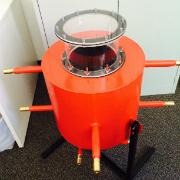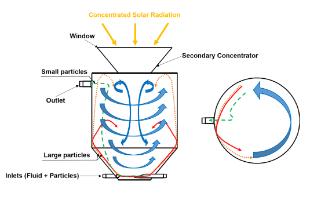Solar Expanding-Vortex Particle Receiver-Reactor (SEVR)
Patented reactor to increase conversion efficiency
At CET, we’re working to make solar technology as efficient as possible and we look at all aspects of a system to make sure we’re getting the best out of them. When it comes to concentrated solar thermal (CST) systems, tubular receivers are commonly used but directly-irradiated particle receivers have the potential to attain higher efficiency and higher temperatures. Of all the particle receivers-reactors proposed to date, the solar expanding vortex reactor (SEVR) has been found to be one of the most promising.
Our SEVR addresses the key challenges associated with SVR systems:
- uneven particle heating and energy destruction
- particles depositing on the receiver-reactor window.
-
About the SEVR
CET’s solar expanding-vortex particle receiver-reactor:
- reduces particle deposition rate by more than 10 times compared to previous designs
- generates a well-established vortex flow pattern within the cavity
- reduces swirl intensity at the aperture plane by up to 10 times
- preferentially recirculates larger particles within the chamber relative to smaller particles
- can achieve prolonged particle residence times when compares to state-of-the-art SEVR technology
- has a large calculated thermal efficiency (> 85%: defined as the ratio of useful heat absorbed and the power input), depending on the particle size.
-
People
-
Applications
-
What's happening now?
-
Facilities

- 100 kW cold flow SEVR model (air):
- measures velocity profiles (gas-phase) using Cobra probe
- measures particle deposition rate
- 5 kW cold flow SEVR model (water tank) – I generation:
- measures velocity profiles (gas-phase) employing particle image velocimetry
- characterises fluid-dynamic instabilities (e.g. precessing vortex core)
- 5 kW cold flow SEVR model (water tank) - II generation (under construction):
- the second (II) generation is based on a more flexible design compared to the I generation, and key geometrical features such as aperture size can be varied
- 5 kW cold flow SEVR model (air) - (under development):
- measure gas and particle residence times
- sealing gas system: measurements of performance and optimisation
- 5 kW hot flow SEVR model (under development):
- measures the thermal performance of the device employing reacting and non-reacting particles
- particle testing under concentrated solar radiation.
- 100 kW cold flow SEVR model (air):

